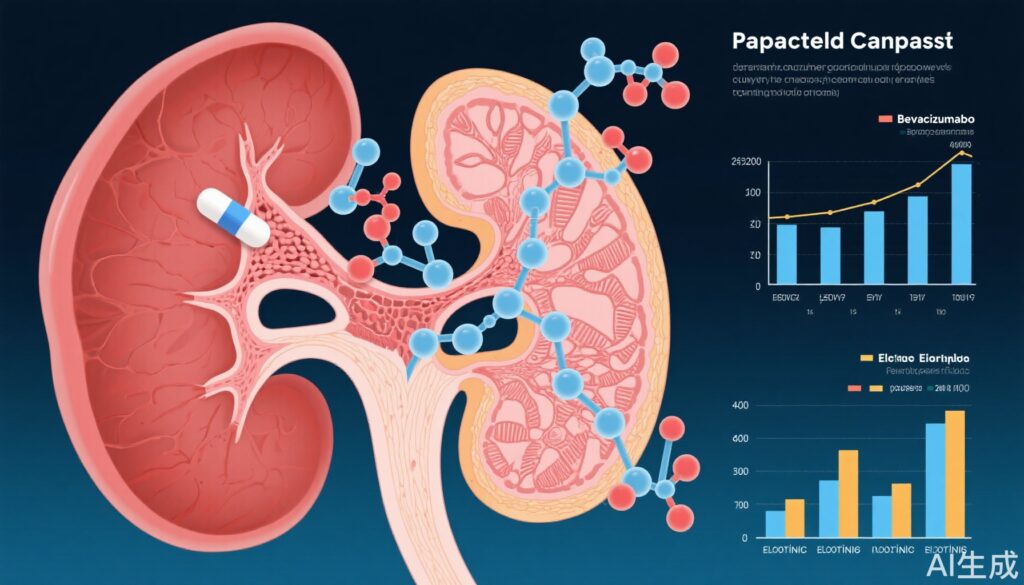Highlights
- Bevacizumab plus erlotinib produced a 72% response rate in HLRCC-associated papillary renal-cell carcinoma, with median progression-free survival of 21.1 months.
- In sporadic papillary renal-cell carcinoma, response rate was 35%, with median progression-free survival of 8.9 months.
- Common side effects included rash, diarrhea, and proteinuria; grade 3 or higher adverse events were mostly hypertension and proteinuria.
- This combination represents the first regimen to demonstrate substantial efficacy in advanced HLRCC-related papillary renal-cell carcinoma.
Clinical Background and Disease Burden
Hereditary leiomyomatosis and renal-cell cancer (HLRCC) is a rare, inherited cancer syndrome caused by germline mutations in the fumarate hydratase (FH) gene. Patients are predisposed to aggressive papillary renal-cell carcinoma (PRCC), which often presents with advanced disease and poor prognosis. Traditional therapies for advanced renal-cell carcinoma, such as VEGF inhibitors or immunotherapy, have limited efficacy in HLRCC-PRCC, leaving a significant unmet clinical need. Sporadic PRCC, the second most common histologic subtype of renal-cell carcinoma, also lacks highly effective targeted treatments. Thus, novel therapeutic approaches are urgently needed for both hereditary and sporadic forms.
Research Methodology
This open-label, phase 2 clinical trial (NCT01130519) investigated whether combining bevacizumab, an anti-VEGF monoclonal antibody, with erlotinib, an EGFR tyrosine kinase inhibitor, could improve outcomes in patients with advanced HLRCC-associated or sporadic PRCC. Patients received bevacizumab (10 mg/kg every two weeks) and erlotinib (150 mg daily). The primary endpoint was overall objective response rate (per RECIST criteria). Secondary endpoints included progression-free survival (PFS) and overall survival (OS). Forty-three patients with HLRCC-associated PRCC and forty with sporadic PRCC were enrolled, reflecting a robust sample size for these rare tumor types.
Key Findings
The combination therapy demonstrated pronounced efficacy, particularly in the HLRCC cohort:
- In HLRCC-associated PRCC (n=43):
- Confirmed objective response rate: 72% (31 patients; 95% CI, 57–83%)
- Median progression-free survival: 21.1 months (95% CI, 15.6–26.6)
- Median overall survival: 44.6 months (95% CI, 32.7 to not estimable)
- In sporadic PRCC (n=40):
- Confirmed objective response rate: 35% (14 patients; 95% CI, 22–51%)
- Median progression-free survival: 8.9 months (95% CI, 5.5–18.3)
- Median overall survival: 18.2 months (95% CI, 12.6–29.3)
Toxicities were consistent with known profiles of the agents: acneiform rash (93%), diarrhea (89%), and proteinuria (78%) were common, while grade 3 or higher hypertension (34%) and proteinuria (17%) were the most frequent severe adverse events. Treatment discontinuation due to toxicity was uncommon, indicating that the regimen was generally manageable.
Mechanistic Insights and Biological Plausibility
HLRCC-associated PRCC is characterized by loss of FH, leading to metabolic dysregulation, pseudo-hypoxia, and upregulation of hypoxia-inducible factors (HIFs). This promotes VEGF-driven angiogenesis and EGFR pathway activation—rationalizing the dual targeting of VEGF (with bevacizumab) and EGFR (with erlotinib). The marked effectiveness of this regimen in HLRCC patients supports the mechanistic hypothesis and provides in vivo confirmation of these pathways’ therapeutic relevance in this rare cancer subtype.
Expert Commentary
This study represents a milestone in the management of HLRCC-associated PRCC, for which there were previously no effective therapies. The response rates in this cohort are unprecedented and suggest that dual pathway inhibition is a rational strategy. For sporadic PRCC, the response is more modest but still clinically meaningful compared to historical controls. Notably, the toxicity profile, while significant, did not preclude sustained therapy for most patients. This regimen could become a new standard of care, pending further validation in randomized trials.
Controversies and Limitations
While the results are compelling, the study is limited by its open-label design, lack of a comparator arm, and relatively small sample size—especially given the heterogeneity of PRCC. Long-term safety, quality of life, and comparative efficacy versus emerging agents (such as MET inhibitors or immunotherapy) remain to be established. Furthermore, generalizability to non-specialist centers or less fit patients requires further study. Additional research should clarify optimal sequencing and combination strategies, particularly in sporadic PRCC where benefits are less dramatic.
Conclusion
The combination of bevacizumab and erlotinib provides the first evidence-based, highly active therapy for advanced HLRCC-associated papillary renal-cell carcinoma, and offers a promising option for sporadic PRCC. The regimen’s mechanistic rationale and favorable benefit-risk profile underscore its potential clinical impact. Ongoing and future trials should address outstanding questions regarding patient selection, long-term outcomes, and integration with other therapies.
References
Srinivasan R, Gurram S, Singer EA, Sidana A, Al Harthy M, Ball MW, Friend JC, Mac L, Purcell E, Vocke CD, Ricketts CJ, Kong HH, Cowen EW, Malayeri AA, Shih JH, Merino MJ, Linehan WM. Bevacizumab and Erlotinib in Hereditary and Sporadic Papillary Kidney Cancer. N Engl J Med. 2025 Jun 19;392(23):2346-2356. doi: 10.1056/NEJMoa2200900. PMID: 40532152.



